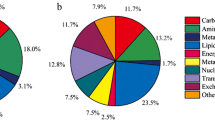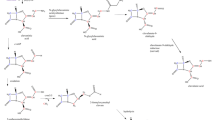Abstract
Spirulina produces γ-linolenic acid (GLA), an important pharmaceutical substance, in a relatively low level compared with fungi and plants, prompting more research to improve its GLA yield. In this study, metabolic flux analysis was applied to determine the cellular metabolic flux distributions in the GLA synthetic pathways of twoSpirulina strains, wild type BP and a high-GLA producing mutant Z19/2. Simplified pathways involving the GLA synthesis ofS. platensis formulated comprise of photosynthesis, gluconeogenesis, the pentose phosphate pathway, the anaplerotic pathway, the tricarboxylic cycle, the GLA synthesis pathway, and the biomass synthesis pathway. A stoichiometric model reflecting these pathways contains 17 intermediates and 22 reactions. Three fluxes—the bicarbonate (C-source) uptake rate, the specific growth rate, and the GLA synthesis rate—were measured and the remaining fluxes were calculated using linear optimization. The calculation showed that the flux through the reaction converting acetyl-CoA into malonyl-CoA in the mutant strain was nearly three times higher than that in the wild-type strain. This finding implies that this reaction is rate controlling. This suggestion was supported by experiments, in which the stimulating factors for this reaction (NADPH and MgCl2) were added into the culture medium, resulting in an increased GLA-synthesis rate in the wild type strain.
Similar content being viewed by others
References
Ciferri, O., (1983)Spirulina, the edible microorganism.Microbiol. Rev. 47: 551–578.
Matsuno, T., S. Nagata, M. Iwahashi, T. Koike, and M. Okada (1979) Intensification of color of fancy red carp with zeaxanthin and myxoxanthophyll, major carotenoid constituents ofSpirulina.Bull. Jpn. Soc. Sci. Fisheries 45: 627–633.
Vonshak, A. (1997) Use ofSpirulina biomass,Spirulina platensis (Arthrospira) physiology cell biology and biotechnology. Taylor & Francis Ltd., UK.
Cohen, Z. (1986)Product from Microalgae. CRC Press Inc., Florida, USA.
Nichols, B. W. and B. J. B. Wood (1968) The occurrence and biosynthesis of gamma-linolenic acid in blue-green alga,Spirulina platensis.Lipids 3: 46–50.
Wright, S. and J. H. Burton (1982) A controlled trial of the treatment of atopic eczema in adults with evening primrose oil (Efamol).Lancet: 1120–1122.
Horrobin, D. F. (1983) The role of essential fatty acids and prostaglandins in the premenstrual syndrome.J. Reprod. Med. 28: 465–468.
Huang, Y. S., M. S. Manku, and D. F. Horrobin (1984) The effect of dietary cholesterol on blood and liver polyunsaturated fatty acids and on plasma cholesterol in rats fed various types of fatty acid diet.Lipids 19: 664–672.
Shimizu, S., Y. Shinmen, H. Kawahima, K. Akimoto, and H. Yamada (1988) Fungal mycelia as a novel source of eicosapentaenoic acid.Biochem. Biophys. Res. Comm. 150: 335.
Wolf, R. B., R. Kleiman, and R. E. England (1983) New sources of γ-linolenic acid (Boraginaceae, Scrophulariaceae, Onagraceae, Saxifragaceae).J. Am. Oil. Chem. Soc. 60: 1858.
Mahajan, G. and M. Kamat (1995) γ-Linolenic acid production fromSpirulina platensis.Appl. Microbiol. Biotechnol. 45: 466–469.
Tanticharoen, M., M. Reungjitchachawali, B. Boonag, P. Vonktaveesuk, A. Vonshak, and Z. Cohen (1994) Optimization of γ-linolenic acid (GLA) production inSpirulina platensis.J. Appl. Phycol. 6: 295–300.
Cohen, Z., A. Vonshak, and A. Richmond (1987) Fatty acid composition ofSpirulina strains grown under various environmental conditions.Phytochemistry 26: 2255–2258.
Suphatrakul, A. (1996)Effect of Temperature on the Expression of the 12-Desaturase Gene (desA)in Spirulina platensisC1. M.S. Thesis, King Mongkut’s University of Technology, Thonburi, Bangkok, Thailand.
Deshnium, P., K. Paithoonrangsarid, A. Suphatrakul, D. Meesapyodsuk, M. Tanticharoen, and S. Cheevadhanarak (2000) Temperature-independent and-dependent expression of desaturase genes in filamentous cyanobacteriumSpirulina platensis strain C1 (Arthrospira sp. PCC 9438).FEMS Lett. 184: 207–213.
Cohen, Z., M. Reungjitchachawali, W. Siangdung, M. Tanticharoen, and Y. M. Heimer (1993) Herbicide resistant lines of microalgae: Growth and fatty acid composition.Phytochemistry 34: 973–978.
Berry, A. (1996) Improving production of aromatic compounds inEscherichia coli by metabolic engineering.Trends Biotechnol. 14: 250–256.
Gourdon, P. and N. D. Lindley (1999) Metabolic analysis of glutamate production byCorynebacterium glutamicum.Met. Eng. 1: 224–231.
Hua, Q., P.-C. Fu, C. Yang, and K. Shimizu (1998) Microaerobic lysine fermentations and metabolic flux analysis.Biochem. Eng. J. 2: 89–100.
Ingram, L. O., P. F. Gomez, X. Lai, M. Moniruzzaman, B. E. Wood, L. P. Yomano, and S. W. York (1998) Metabolic engineering of bacteria for ethanol production.Biotechnol. Bioeng. 58: 204–214.
Vallino, J. J. and G. Stephanopoulos (1993) Metabolic flux distributions inCorynebacterium glutamicum during growth and lysine overproduction.Biotechnol. Bioeng. 41: 633–646.
Vonshak, A. (1986)Laboratory Techniques for the Cultivation of Microalgae: CRC Handbook of Microalgal Mass Cultures. CRC Press, Florida, USA.
Dubois, M., K. A. Gilles, J. K. Hamilton, P. A. Rebers, and F. Smith (1956) Colorimetric method for determination of sugar and related substances.Analy. Chem. 28: 350–356.
Allen, I. F. and N. G. Homes (1986)Electron Transport and Redox Titration: Photosynthesis Energy Transfuction. a Practical Approach. Information Printing Ltd., Oxford, UK.
Kaneko, T., S. Sato, H. Kotani, A. Tanaka, E. Asumizu, Y. Nakamura, N. Miyajima, and M. Hirosawa (1996) Sequence analysis of the genome of the unicellular cyanobacteriumSynechocystis sp. strain PCC 6803. II Sequence determination of the entire genome and assigment of potential protein-coding regions.DNA Res. 3: 109–136.
Kaneko, T., S. Sato, H. Kotani, A. Tanak, E. Asumizu, Y. Nakamura, Miyajima, and M. Hirosawa (1996) Sequence analysis of the genome of the unicellular cyanobacteriumSynechocystis sp. strain PCC 6803. II. Sequence determination of the entire genome and assigment of potential protein-coding regions (supplement).DNA Res. 3: 185–209.
Hua, Q. and K. Shimizu (1999) Effect of dissoved ozygen concentration on the intracellular flux distribution for pyruvate fermentation.J. Biotechnol. 68: 135–147.
Daae, B. E. and A. P. Ison (1999) Classification and sensitivity analysis of a proposed primary metabolic reaction network forStreptomyces lividans.Met. Eng. 1: 153–165.
Stephanopoulos, G., A. A. Aristidou, and J. Nielsen (1998)Metabolic Engineering: Principles and Methodologies. Academic Press, San Diego, USA.
Yang, C., Q. Hua, and K. Shimizu (2000) Energetics and carbon metabolism during growth of microalgal cells under photoautotrophic, mixotrophic and cyclic light-autotrophic/dark-heterotrophic conditions.Biochem. Eng. J. 6: 87–102.
Laing, W. A. (1992) The regulation of acetyl-CoA carboxylase.Res. Photosyn. 3: 39–42.
Author information
Authors and Affiliations
Corresponding author
Rights and permissions
About this article
Cite this article
Meechai, A., Pongakarakun, S., Deshnium, P. et al. Metabolic flux distribution for γ-linolenic acid synthetic pathways inSpirulina platensis . Biotechnol. Bioprocess Eng. 9, 506–513 (2004). https://doi.org/10.1007/BF02933494
Received:
Accepted:
Issue Date:
DOI: https://doi.org/10.1007/BF02933494




